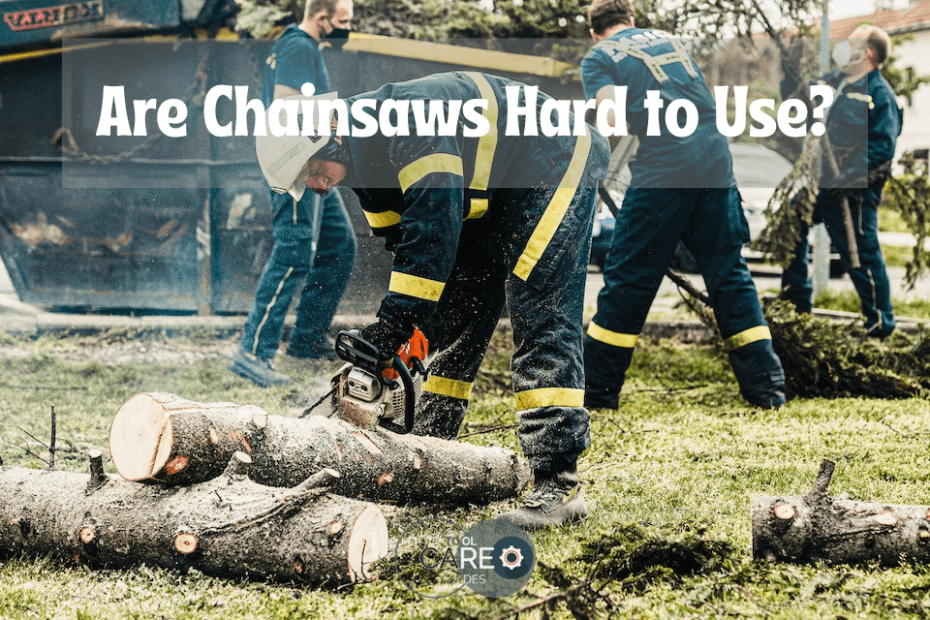Quick Overview of This Article
Chainsaws can be difficult to use, requiring training to avoid potential hazards and accidents. Using a chainsaw without proper training can lead to dangerous situations and potential injuries.
It is crucial to learn how to operate a chainsaw safely and effectively to prevent accidents that can have severe consequences. Without proper training, slight errors can quickly turn a worksite into a bloody or fatal scene. Moreover, it is important to note that chainsaws require regular maintenance and proper storage to ensure their longevity and optimal performance.
By familiarizing yourself with the proper techniques and safety precautions, you can confidently and safely use a chainsaw for various tasks.
Which Types Of Chainsaws Are The Hardest To Use?
The types of chainsaws that are the hardest to use are typically large, heavy, and powerful models. These chainsaws require more strength and skill to control effectively, making them more challenging for beginners or those with less experience. However, with proper training and practice, anyone can learn to use a chainsaw safely and efficiently.
When it comes to using chainsaws, some types can be more challenging to handle than others. Here are the types of chainsaws that may require more experience and skill:
- Gas-powered chainsaws: These chainsaws are known for their power and versatility, but they can be more difficult to handle compared to electric or battery-powered chainsaws. The need for a mixture of fuel and oil, as well as the requirement for manual starting, can make gas-powered chainsaws more challenging for beginners.
- Professional-grade chainsaws: Designed for heavy-duty and professional use, these chainsaws are typically larger, heavier, and more powerful. They often feature longer guide bars, which can make them harder to maneuver for beginners. Professional-grade chainsaws are best suited for experienced users who are familiar with handling such powerful equipment safely.
- Top-handled chainsaws: These chainsaws are designed specifically for arborists and tree care professionals who work in elevated positions. Top-handled chainsaws are lightweight and compact, but their unique design requires skill and experience to operate safely. They are typically used for tree pruning and trimming tasks at height.
- Chainsaws with advanced features: Some chainsaws come with additional features such as anti-vibration technology, automatic chain oilers, and quick-adjust chain tensioning systems. While these features can enhance the performance and convenience of the chainsaw, they may also add complexity to the operation. Beginners might find it more challenging to manage these advanced features effectively.
When it comes to chainsaws, certain types require more skill and experience to use. Gas-powered chainsaws, professional-grade chainsaws, top-handled chainsaws, and chainsaws with advanced features can be more challenging for beginners. It is essential to receive proper training and practice to use these chainsaws safely and effectively.
What Things Make Chainsaws Hard To Use?
Chainsaws can be difficult to use due to their weight, vibrations, and potential kickback. It is important to receive proper training and take precautions to ensure safe and effective operation.
What Makes Chainsaws Hard To Use?
Chainsaws can be a powerful and useful tool, but they can also be challenging to operate, especially for beginners. Here are some factors that can make chainsaws hard to use:
Safety concerns
One of the main reasons chainsaws can be difficult to handle is because of safety concerns. The sharp, fast-moving chain can cause serious injuries if not used properly. It’s important to understand safety protocols and always wear appropriate protective gear when operating a chainsaw.
Weight and size
Chainsaws can be heavy and bulky, which can make them challenging to maneuver, especially for individuals who are not physically strong or have limited upper body strength. Holding and controlling the weight of the chainsaw can require a certain level of stamina and coordination.
Vibration and kickback
Chainsaws produce vibrations that can cause fatigue and discomfort, which can make it tiring to use them for extended periods. Additionally, kickback, which occurs when the chainsaw’s bar suddenly jerks towards the operator, can be dangerous and difficult to manage, especially for inexperienced users.
Noise and fumes
Chainsaws are notoriously loud and produce emissions, which can be bothersome and potentially harmful if not used in a well-ventilated area. Noise-canceling hearing protection and proper ventilation are essential to minimize the negative effects of both noise and fumes.
Maintenance and sharpening
Chainsaws require regular maintenance, including chain sharpening, oiling, and cleaning. This maintenance can be time-consuming and require proper knowledge and tools. Failing to maintain the chainsaw correctly can lead to poor performance and potential safety hazards.
Complexity of operation
Chainsaws have various features and controls that need to be understood and operated correctly. Learning how to start, stop, adjust the chain tension, and engage the safety mechanisms can be overwhelming for beginners. It takes time and practice to become familiar and comfortable with all the controls.
While chainsaws can be challenging to use, with proper training, practice, and safety precautions, anyone can learn how to operate them effectively and safely. It’s important to prioritize safety and take the time to become familiar with the tool before attempting any cutting tasks.
How Difficult Are The Different Types Of Work You Can Do With A Chainsaw?
Using a chainsaw requires caution and proper training to avoid accidents. Whether it’s felling trees or cutting firewood, understanding how to handle a chainsaw safely is crucial to prevent injury and ensure efficient work.
When it comes to using a chainsaw, many people wonder how difficult it is to handle different types of work. Whether you’re a beginner or have some experience, it’s important to understand the level of difficulty involved in various chainsaw tasks.
This section will outline the challenges and requirements associated with different types of work you can do with a chainsaw.
Cutting Small Branches And Light Material
- Hold the chainsaw firmly with both hands.
- Ensure that the tip of the chainsaw doesn’t touch any objects.
- Take extra caution when cutting twigs and other light materials.
- Be careful when re-entering a cut to avoid accidents.
Pruning Trees And Shrubs
- Evaluate the tree or shrub to determine the right branches to prune.
- Plan your cuts to maintain the tree’s health and aesthetics.
- Use proper cutting techniques to avoid damaging the tree or shrub.
- Make strategic cuts, such as removing dead or diseased branches, to improve the overall appearance of the plant.
Cutting Large Trees
- Assess the tree and its surroundings for potential hazards.
- Plan the felling direction and make sure you have a clear escape route.
- Make precise cuts to control the tree’s fall.
- Use proper safety gear, such as protective clothing and a hard hat.
- Consider hiring a professional if you’re uncertain about felling large trees.
Logging And Firewood Production
- Understand the regulations and requirements for logging in your area.
- Have the necessary equipment, including safety gear and a chainsaw with appropriate power and length.
- Know how to make accurate cuts to optimize the quality and quantity of the wood.
- Follow proper safety guidelines, such as wearing ear protection and using the chainsaw at the correct angle.
From cutting small branches to logging and firewood production, the difficulty level of using a chainsaw depends on the task at hand. It’s crucial to have the right knowledge, skills, and safety precautions to ensure successful and safe chainsaw operation.
Always prioritize your safety and consider seeking professional assistance when dealing with more challenging tasks. With practice and proper training, you can become skilled in using a chainsaw for a wide range of work.
The Dos And Don’ts Of Chainsaw Use
Chainsaws can be challenging to use, but by following these dos and don’ts, you can ensure safe and effective operation. Always hold the chainsaw firmly with both hands, avoid contact with objects, and exercise caution when cutting twigs and re-entering a cut.
Chainsaw training is recommended to avoid accidents and potential injuries.
You, but chainsaws can be dangerous if not used properly. However, with the right knowledge and precautions, anyone can safely and effectively use a chainsaw. In this blog post, we will discuss the dos and don’ts of chainsaw use to ensure that you have a safe and successful experience.
Dos Of Chainsaw Use:
- Wear appropriate protective gear: Always wear safety goggles or a full-face shield, hearing protection, cut-resistant gloves, and chainsaw chaps or protective pants. This will protect you from potential injuries caused by flying debris or accidental contact with the chainsaw.
- Familiarize yourself with the chainsaw: Before using a chainsaw, read the manufacturer’s manual and familiarize yourself with the specific model you will be using. Understand how to start and stop the chainsaw, how to properly hold it, and how to engage the chain brake.
- Choose the right chainsaw for the task: Different types of chainsaws are designed for different tasks. Make sure you select a chainsaw that is appropriate for the size and type of wood you will be cutting. Using the wrong chainsaw can increase the risk of accidents.
- Maintain a firm grip: Always hold the chainsaw with both hands to maintain control and stability. Use a firm grip and wrap your fingers securely around the handles. This will help prevent the chainsaw from slipping or being forced out of your hands during operation.
- Practice safe cutting techniques: Start by ensuring the area around the cutting site is clear of obstacles and bystanders. Hold the chainsaw with a secure grip and position your body in a stable stance. Use smooth and controlled movements when cutting, and never force the chainsaw through the wood. Let the chainsaw’s weight and sharpness do the work.
Don’ts Of Chainsaw Use:
- Don’t operate a chainsaw alone: Always have a buddy nearby who is familiar with chainsaw safety. They can provide assistance if an accident occurs and help ensure that you are following proper safety procedures.
- Don’t cut above shoulder height: Avoid cutting branches or logs that are positioned above your shoulder level. This can cause loss of control and make it difficult to handle the chainsaw safely. Instead, use a ladder or other equipment to reach higher areas.
- Don’t ignore maintenance: Regularly maintain your chainsaw by cleaning it, sharpening the chain, and inspecting for any damaged or worn parts. A well-maintained chainsaw will operate more efficiently and reduce the risk of accidents.
- Don’t rush: Take your time when operating a chainsaw. Rushing can lead to sloppy and unsafe cutting techniques. Stay focused, be patient, and always prioritize safety over speed.
- Don’t use a chainsaw if you are fatigued or under the influence: Operating a chainsaw requires concentration and physical stamina. Avoid using a chainsaw if you are feeling tired, mentally impaired, or have consumed alcohol or drugs that may affect your coordination or judgment.
Remember, chainsaw use can be safe and successful if you follow these dos and don’ts. Prioritize safety, wear protective gear, and always use the chainsaw in a controlled and cautious manner. With the right knowledge and precautions, you can confidently tackle any cutting task with a chainsaw.
Stay safe and happy cutting!
Frequently Asked Questions
How Do You Use A Chainsaw For Beginners?
To use a chainsaw for beginners:
1. Hold the chainsaw firmly with both hands.
2. Avoid touching the tip of the chainsaw against any objects.
3. Be cautious when cutting twigs and light material. 4. Exercise caution when re-entering a cut.
Can You Use A Chainsaw Without Training?
No, you should not use a chainsaw without proper training to avoid accidents and potential injuries.
What Are The Disadvantages Of Chainsaw?
Disadvantages of chainsaws include the need to cool down gas chainsaws when refueling and the requirement to wait if they run out of gas during a job. Storage can also be a disadvantage as gas chainsaws must cool down before being stored.
What Do I Need To Know Before Buying A Chainsaw?
Before buying a chainsaw, there are a few key things to know:
1. Safety and Training: It’s essential to receive proper training to use a chainsaw safely and avoid accidents.
2. Maintenance and Fuel: Gas chainsaws require regular maintenance and fuel refills during use, which may interrupt your work.
3. Noise and Emissions: Chainsaws, especially gas-powered ones, can be loud and emit pollutants.
4. Storage and Handling: Proper storage and handling are necessary, including allowing the chainsaw to cool down before covering and storing it. Remember to seek training, consider maintenance and fuel requirements, be mindful of noise and emissions, and handle and store your chainsaw correctly.
Conclusion
Chainsaws may seem intimidating to use, but with proper training and precautions, they can be operated safely and effectively. It is crucial to undergo chainsaw training to avoid accidents and ensure you understand how to handle the tool correctly. Without training, simple mistakes can quickly turn a worksite into a dangerous situation.
Chainsaws also require regular maintenance and care, including fueling and cooling down, which can interrupt your work if not managed properly. Additionally, storage can be a challenge as gas chainsaws need to cool down before their blade covers are put on for safekeeping.
Despite these disadvantages, chainsaws offer a powerful and efficient way to tackle various tasks like felling trees and cutting firewood. By following proper safety protocols and receiving the necessary training, anyone can learn to use a chainsaw effectively and safely.




